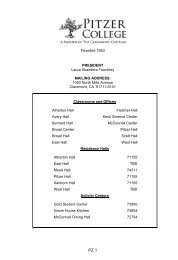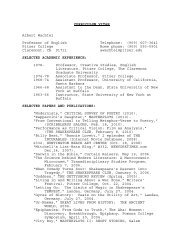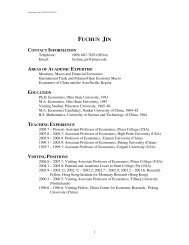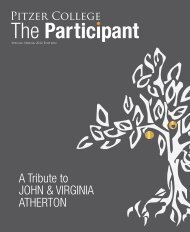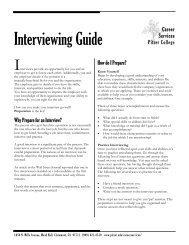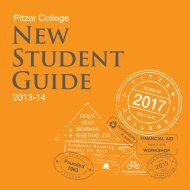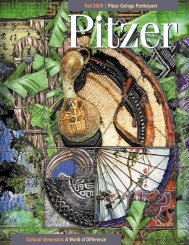Fall 2003 Participant - Pitzer College
Fall 2003 Participant - Pitzer College
Fall 2003 Participant - Pitzer College
You also want an ePaper? Increase the reach of your titles
YUMPU automatically turns print PDFs into web optimized ePapers that Google loves.
Full Circle<br />
Professor Paul Faulstich’s<br />
Fulbright research marked<br />
his return to the people with<br />
whom he began his career.<br />
Paul Faulstich, professor of<br />
environmental studies at <strong>Pitzer</strong>,<br />
recently returned to the <strong>College</strong><br />
after completing a Fulbright<br />
Fellowship research project among<br />
the Warlpiri, a group of Aboriginal<br />
people in Australia.<br />
Faulstich grew up in Alhambra, about<br />
25 miles west of Claremont, and was a<br />
student at <strong>Pitzer</strong> from 1975 to 1979,<br />
majoring in environmental studies and<br />
art. He earned his Ph.D. in cultural<br />
anthropology from the East-West Center<br />
and the University of Hawaii and his<br />
M.A. in anthropology and symbolic<br />
archaeology from Stanford.<br />
He came back to <strong>Pitzer</strong> as a visiting<br />
professor in 1991. He returned again in<br />
1993 and has been with the <strong>College</strong>’s<br />
Environmental Studies program since<br />
that time.<br />
“<strong>Pitzer</strong> was my college of choice<br />
because of its solid academics, its<br />
attention to the individual student, and its<br />
flexibility of curriculum. When I was a<br />
student here, I remember looking up to<br />
my professors and thinking that I couldn’t<br />
imagine a better career. I still feel this<br />
way,” Faulstich said.<br />
The first two courses Faulstich taught<br />
in 1991 were “The Desert as a Place,”<br />
which he inherited from Professors Carl<br />
Hertel and Paul Shepard, and “Victims of<br />
Progress,” which over the years has<br />
developed into his current course<br />
“Progress and Oppression: Ecology,<br />
Human Rights and Development.”<br />
“We continue to honor our heritage,”<br />
Faulstich said about the changes in<br />
Environmental Studies at <strong>Pitzer</strong> since he<br />
started teaching. “John Rodman was<br />
instrumental in establishing the<br />
environmental studies program at <strong>Pitzer</strong>.<br />
This innovative program was one of the<br />
first in the world, and continues to be<br />
unique in its emphasis on a broadly<br />
defined human ecology. Paul Shepard and<br />
Carl Hertel joined with John in creating<br />
the vision for our program. They forged a<br />
Karina Faulstich<br />
Paul Faulstich carries a piece of wood to be used for making a boomerang<br />
while on his Fulbright trip in Australia.<br />
program that is unique in its concern with<br />
relationships between humans and the<br />
more-than-human world.”<br />
“Our curriculum includes community<br />
service courses, outreach programs,<br />
extracurricular activities, and our ‘handson’<br />
emphasis,” Faulstich said. “Some<br />
recent and exciting developments in our<br />
program include the evolution of the<br />
Ecology Center, expansion of the John<br />
Rodman Arboretum, development of new<br />
courses, increased intercollegiate links,<br />
the Leadership in Environmental<br />
Education Partnership (LEEP), and the<br />
hiring of Melinda Herrold-Menzies. In<br />
1998 the Environmental Studies Field<br />
Group completed a comprehensive<br />
redesign of our curriculum, and new<br />
concentration requirements are now in<br />
effect. Recent programmatic<br />
developments mark a renewed emphasis<br />
on activism, academic rigor, social<br />
responsibility, and community<br />
involvement.”<br />
“With the hiring of Melinda, we are<br />
increasing our emphasis on natural<br />
history, while maintaining our social<br />
science perspective. Natural history<br />
integrates keen observation of nature with<br />
an acknowledgement (indeed, an<br />
affirmation) that humans are sentient<br />
beings. Hence, it mixes the scientific<br />
perspective with elegant, heart-felt and<br />
intelligent responses to science. We<br />
searched for two years to find the right<br />
person to fill our new position, and with<br />
Melinda, we’ll be able to create stronger<br />
links with the Joint Science Department.<br />
This will allow us to incorporate more<br />
successfully the scientific dimension<br />
while strengthening our focus on human<br />
ecology.”<br />
“The kind of natural history we are<br />
expanding within our curriculum involves<br />
the integrated study of the relationships<br />
among and between the biophysical and<br />
cultural components of natural<br />
environments,” Faulstich said. “Emphasis<br />
is placed on developing an understanding<br />
of ecological and geological principles<br />
evident in natural ecosystems and how<br />
these interface with human social<br />
systems.”<br />
“Environmental Studies has operated<br />
as an interdisciplinary program, providing<br />
environmental education for <strong>Pitzer</strong><br />
10 <strong>Pitzer</strong> <strong>College</strong> <strong>Participant</strong>


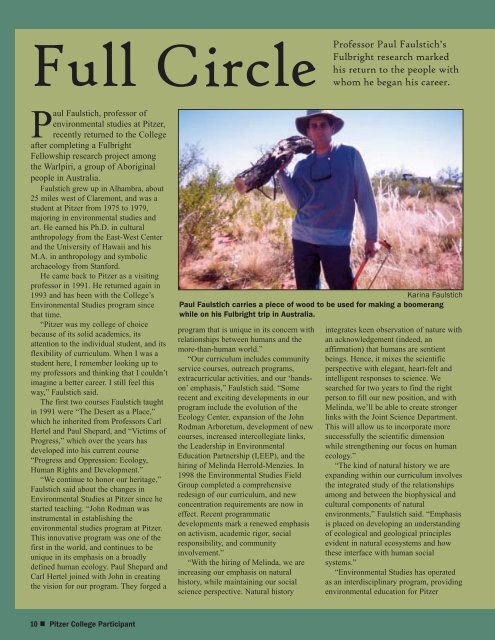
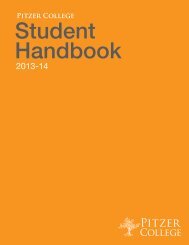

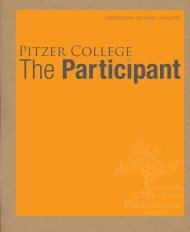
![Anticipated Courses SP14 [pdf] - Pomona College](https://img.yumpu.com/25363335/1/190x245/anticipated-courses-sp14-pdf-pomona-college.jpg?quality=85)

